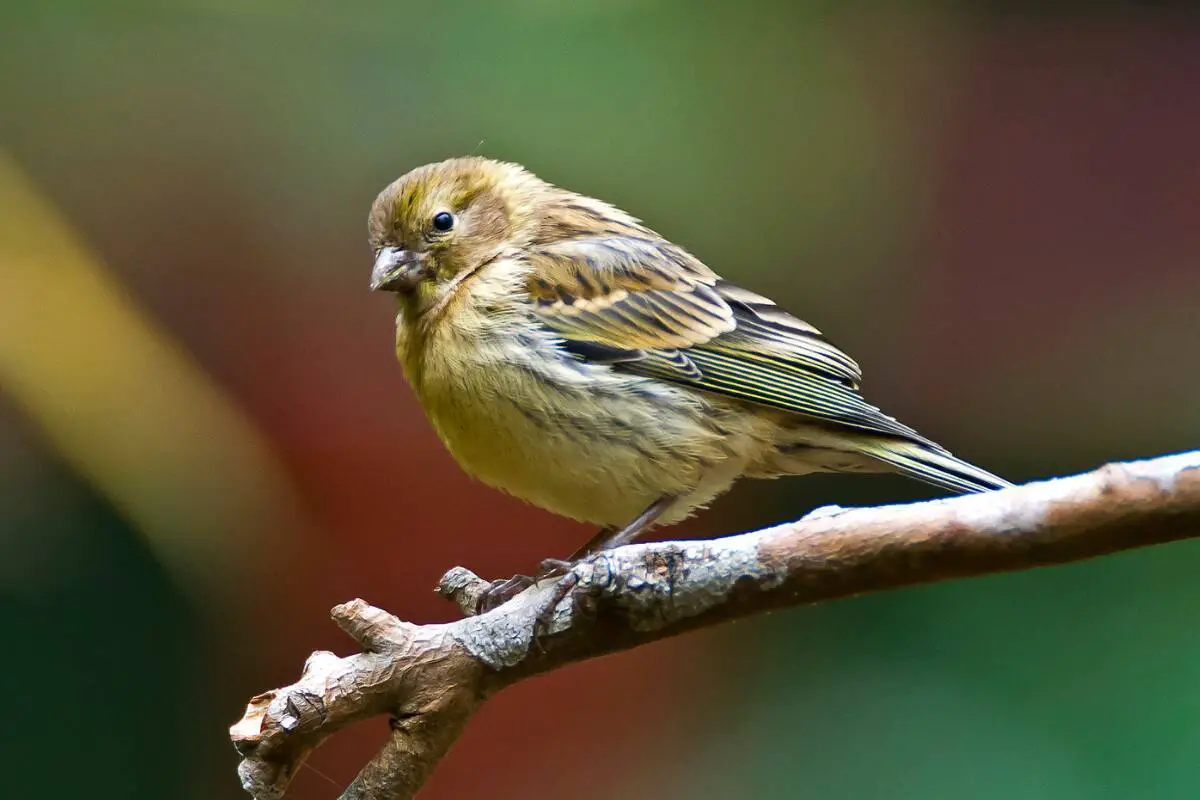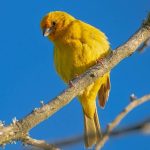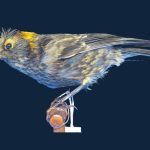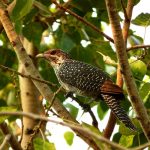Island canary | image by Juan Emilio via Flickr | CC BY-SA 2.0
Common Name: Island Canary
Scientific Name: (Serinus canaria)| Size | Diet | Range in Hawaii | Status in Hawaii |
|---|---|---|---|
| 4.7 in. - 5.9 in. | seeds, grains, fruits, and buds | Unknown | Least Concern |
The Island Canary (Serinus canaria), also known as the Common Canary or Atlantic Canary, is a charming and colorful bird species that is known for its striking yellow plumage and melodious singing. With its sweet melodies and playful behavior, this canary is a beloved sight in its natural habitat.
Although it is not a native species to Hawaii, the Island Canary has been established on the islands as a naturalized (non-native) resident for a long time. In this article, we’ll explore the fascinating world of the Island Canary and learn more about its establishment in Hawaii.
Island Canary
Appearance
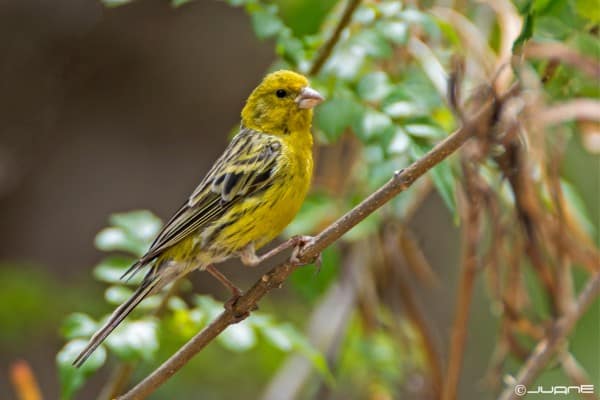
The Island Canary is a small songbird known for its vibrant and diverse plumage. It has an average size of approximately 4.7 to 5.9 inches (12 to 15 centimeters) in length. The appearance of Island Canaries can vary depending on selective breeding by aviculturists.
Native populations in the Madeira, Azores, and Canary Islands are typically dull yellow to whitish streaked brown. However, aviculturists have selectively bred them to exhibit uniformly pale yellow plumage, with some variants showing orange and red hues.
Diet
The Island Canary has a primarily herbivorous diet. In the wild, its diet consists of a variety of plant-based foods, including seeds, grains, fruits, and buds. The specific food sources may vary depending on the available vegetation in its habitat.
Island Canaries have a particular fondness for various types of seeds, such as those from grasses and other plants. They may also consume small amounts of insects and other invertebrates, especially during the breeding season when they require additional protein for themselves and their offspring.
In captivity, Island Canaries are typically provided with a diet of high-quality seeds, fresh fruits, vegetables, and occasional supplements to ensure their nutritional needs are met.
Nesting
The Island Canary builds its nest using various materials found in its environment. The female is primarily responsible for nest construction, although both males and females may gather nesting materials.
The nest is typically built in trees or shrubs, utilizing grass, twigs, leaves, and other plant matter. The female weaves these materials together to create a cup-shaped structure that provides a safe and secure place for egg-laying and incubation.
Island Canaries are known to be monogamous and form pair bonds during the breeding season. The female lays a clutch of several eggs, usually ranging from 3 to 6 eggs, which she incubates for approximately 13 to 14 days. Both parents take turns incubating the eggs and providing care to the hatchlings.
After the eggs hatch, the parents feed the nestlings a diet consisting of regurgitated food, which includes a mixture of partially digested seeds and insects. The nestlings grow rapidly under the care of their parents and typically fledge the nest after about 14 to 17 days.
Behavior

The Island Canary is a social bird that exhibits various behaviors characteristic of its species. They are known for their melodious songs, which they use for communication and territorial defense.
Males sing to attract mates and establish breeding territories, producing a series of musical notes, trills, and warbles. Island Canaries are agile fliers, utilizing flight for foraging, evading predators, and traveling between different areas.
They primarily forage on the ground, searching for seeds, grains, and small plant parts, and may also consume small insects for added protein. During the breeding season, males engage in courtship displays involving singing and wing fluttering to attract females.
Once pair bonds are formed, both parents participate in incubating the eggs and feeding the young. Island Canaries are territorial, with males defending their breeding territories through posturing, song duels, and aggressive behavior. They typically roost together in trees or shrubs, providing safety, warmth, and social interaction. Females select nest sites and construct nests using plant materials.
Habitat
The Island Canary is native to the Madeira, Azores, and western Canary Islands, where it occupies various habitats within its range. These habitats include diverse environments such as forests, woodlands, scrublands, and open areas with scattered trees and shrubs.
Island Canaries are adaptable and can be found in both natural and human-altered landscapes. They are often associated with areas that provide a mix of vegetation types, including grasses, herbs, and small shrubs.
Range
The Island Canary is primarily found in the Madeira, Azores, and western Canary Islands and is not native to Hawaii. However, the species has successfully established a population on Midway Atoll in the Northwestern Hawaiian Islands.
This population originated from birds brought from Honolulu in 1909 and has thrived on the atoll due to the absence of predators and supplemental feeding by residents. Island Canaries have also been reported on Kure Atoll, likely originating from the Midway population.
The range of the Island Canary in Hawaii is limited to these specific islands in the Northwestern Hawaiian Islands, where they have become successfully established.
Conservation Status
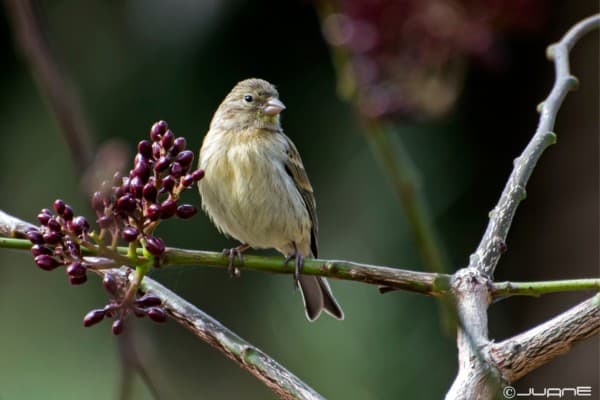
The Island Canary is listed as Least Concern by the International Union for Conservation of Nature (IUCN). This status indicates that the species is not currently facing significant threats or experiencing a significant population decline.
Interesting Facts
1. Singing delight
Island Canaries are renowned for their melodious songs, which are highly valued by bird enthusiasts and have made them popular as caged birds.
2. Successful rat survival
Island Canaries on Midway Atoll showed resilience by surviving the presence of rats, potentially due to their ability to nest high up in Casuarina trees, out of reach of the rodents.
3. Summer bleaching
During the summer months, Island Canaries on Midway Atoll can appear nearly white due to a natural bleaching process, adding to the variety of their plumage.
4. Colorful variants
While wild Island Canaries have a dull yellow to whitish streaked brown plumage, aviculturists have selectively bred them to exhibit uniformly pale yellow colors, as well as orange and red variants.
Frequently Asked Questions
1. How long do Island Canaries live?
With proper care, Island Canaries can live for about 10 to 15 years, although some individuals have been known to live longer.
2. Can Island Canaries mimic human speech?
Island Canaries are not known for their ability to mimic human speech. They are primarily known for their melodious songs.
3. Do Island Canaries require any special care?
Island Canaries require a balanced diet, including seeds, fresh fruits, and vegetables. They also need a suitable cage with enough space for flying and regular exercise.
4. Can Island Canaries be kept as pets?
Yes, Island Canaries can be kept as pets. They are popular for their attractive plumage and melodious songs.
